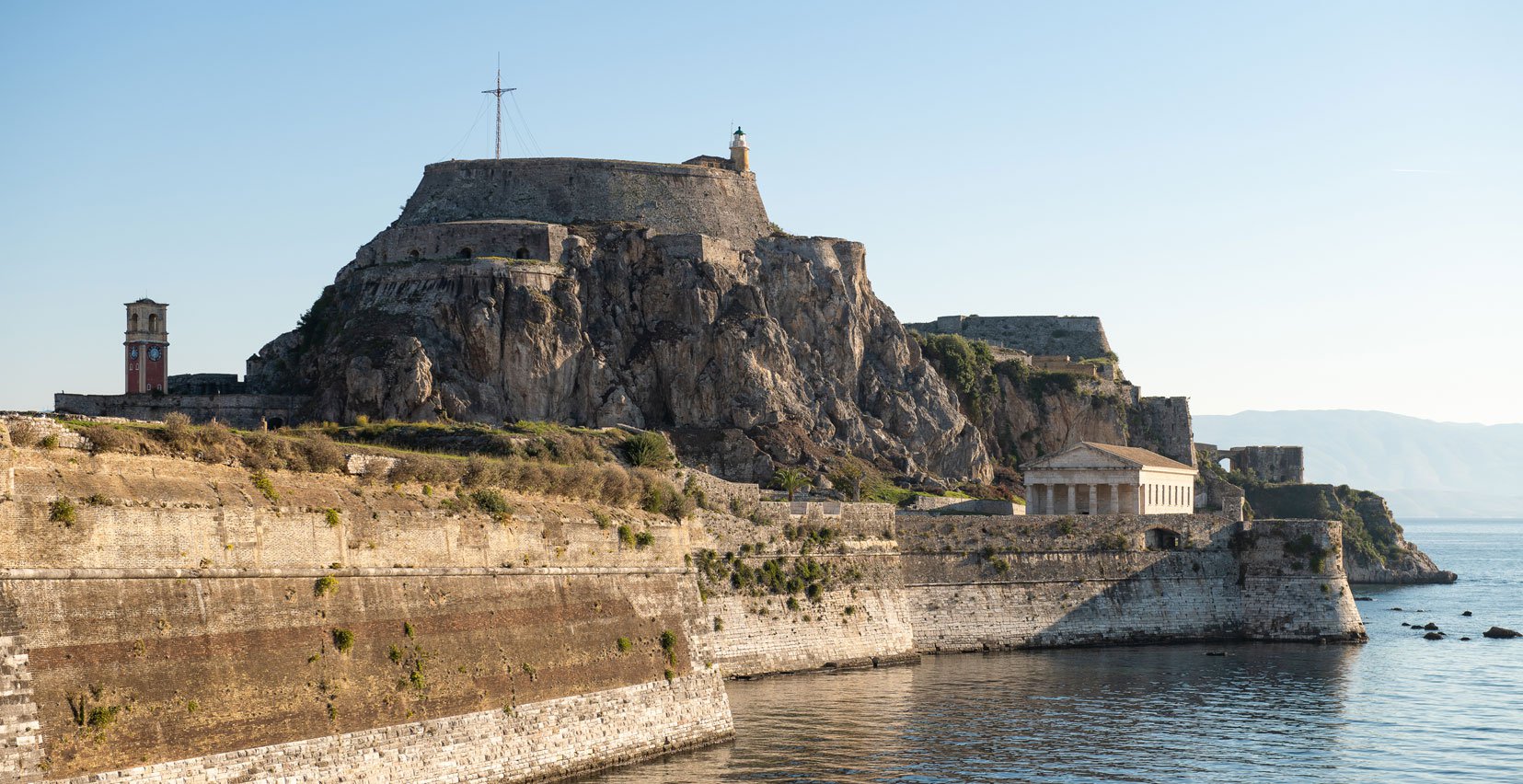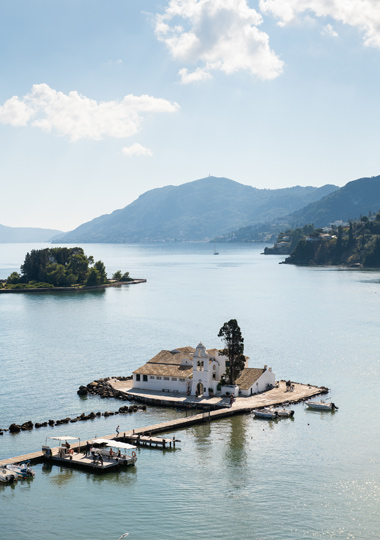PLACES
Every corner of Corfu and a hidden treasure! No other island combines harmoniously relaxed holidays full of cultural references and a cosmopolitan aura that takes one to another era. The island is full of sights of unique historical and cultural interest. From the beautiful old town and the fortresses surrounding it to the museums of great archaeological and historical interest, the visitor can admire this cosmopolitan island's unique architectural and natural beauty. Get ready for exploration and admire the secrets of Corfu!
PONTIKONISI
Pontikonisi, a small island with the chapel of Vlacherna Monastery, is Corfu's most characteristic and popular landscape. It is located at the entrance of Halikiopoulos bay, next to the island's airport. You can visit it with the boats that start next to the chapel. At the top is the Byzantine church of Pantokratoras, which is surrounded by dense vegetation. The name probably came from the size and shape of the island, as seen from above. During the Homeric approach, this was the petrified vessel where Odysseus was transported from the Phaeacians to Ithaca.
KAISER BRIDGE
In the area of Achilleion, there is a work of unique 20th-century sculpture made by the German emperor William II, known as Kaiser. Kaiser's love for the sea led him to build the bridge that connected the vast estate of Achilleion with the beach, guaranteeing him and his royal guests direct and private access to and from the coast. The original bridge was arched and passed over the main road connecting Benitses with Corfu. Today, the arched shape has not survived; however, the part of the bridge that is left is equally impressive.
OLD AND NEW FORTRESS
The two fortresses on the boundaries of which Corfu town is built are monuments of unparalleled beauty and aesthetics and stand proudly "protecting" the city's borders. The history of the Old Fortress began in the middle of the 6th century AD, when the ancient city of Corfu on the peninsula of Kanoni was destroyed by barbarian raids. Then, its inhabitants move gradually to the naturally fortified two-headed peninsula of the Old Fortress, where the Byzantine city, the so-called Korifo (hence Corfu), will develop. The New Fortress was built by the Venetians in the 16th century, when it became imperative to protect the city, the security of which could no longer be ensured by the Old Fortress.
PALACE OF ST. MICHAEL AND ST. GEORGE
The Palace of St. Michael and St. George covers the entire northern side of Spianada, the central square of the historical center. This exquisite two-story palace dates back to the beginning of the 19th century and incorporates a long series of Doric columns with two symmetrical, arched gates bearing the names of the two saints and a series of sculptural representations of the Ionian islands that adorn the facade. Inside, the central hall is surrounded by a double row of Ionic columns and decorated with scenes from the Odyssey. On the ground floor, temporary exhibitions are held today.
JEWISH SYNAGOGUE
The first presence of Jews in Corfu is recorded in the 12th century, and the original medieval Jewish settlement in Corfu town took place in Kampielo, which was called the "Jewish hill". In the 16th century, during Venetian rule, the Jewish community and the Synagogue were transferred by decree to their present location, between Velissariou, Agias Sofias, and Palaiologou streets. After the destruction, in 1537, of the first Synagogue, called "Poulieza," a new one, called "Vecchia" (Old) or "of Misdrachi," was built on Palaiologou Street. It was also burned in 1916 and rebuilt, but burned again in 1943. Today's Synagogue, called "Nuova" (New), on Velissariou Street, was built under British Protection and houses the offices of the local Jewish Community.
ARCHAEOLOGICAL MUSEUM OF CORFU
The Archaeological Museum of Corfu has been housed since 1967 in the area of Garitsa in a two-story building. The Museum houses antiquities from the ancient city of Corfu and the rest of the island. There are exhibits from the Paleolithic to the Bronze Age on the ground floor and the prehistoric collection. In the next room, there are findings from the city's founding in the late 8th century BC. On the first floor, the historical course of Corfu from the 7th BC to the 4th century AD is shown. In the halls of the first floor, findings from the market, ports, sanctuaries, private houses of ancient Corfu, as well as indicative exhibits from other parts of the island are exhibited.
BANKNOTE MUSEUM OF THE IONIAN BANK
The Banknote Museum of the Ionian Bank is housed on the first floor of the listed building, where the first branch of the Ionian Bank opened in 1840 in Corfu. It is a two-story building with Ionic half-columns on the facade and pediment, a work of the Corfiot architect Ioannis Chronis. On the ground floor, the first branch of the Ionian Bank operated, while the first floor, where today the permanent exhibition of the Banknote Collection is housed, was the residence of the respective Branch Manager. The permanent exhibition of the banknote collection covers 180 years of history with 43 display cases, including, among others, 550 banknotes circulated throughout the history of the modern Greek state.
ACHILLEION
Achilleion is one of the most famous royal palaces in Europe and one of Corfu's most important architectural works. It is located in Gastouri and was designed by architects Raffaele Caritto and Antonio Landi. It was built in 1890 at the expense of Empress Elizabeth of Austria and dedicated to Achilles, the enclosure enriched with statues from ancient Greek mythology. It is Pompeian style. In the interior, there are frescoes and decorations of influential artists of the time of its construction; on the second floor, there is an Ionic peristyle. Lush green gardens surround the palace, with views to the north and south, full of bougainvilleas and palm trees. The gardens adorn many statues, mainly of Achilles.







